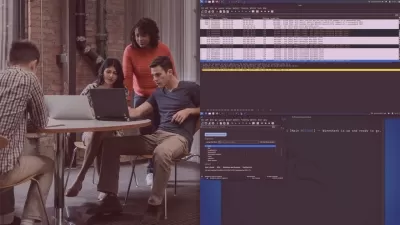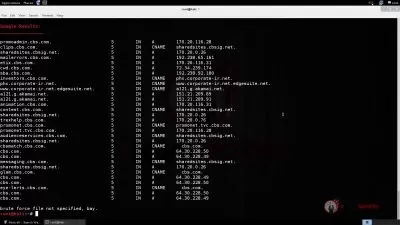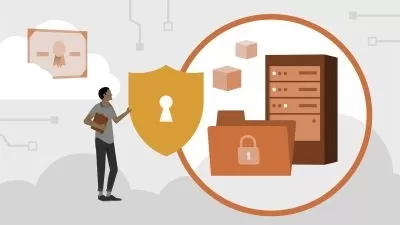Ethical Hacking: Network Security & Network Layer Attack
Muharrem AYDIN,OAK Academy Team
6:48:24
Description
Learn Ethical Hacking with Network Security, Sniffing, Subnetting, Networking, Password Cracking & implement MitM attack
What You'll Learn?
- Ethical hacking involves a hacker agreeing with an organization or individual who authorizes the hacker to levy cyber attacks on a system.
- Becoming an ethical hacker involves learning at least one programming language and having a working knowledge of other common languages like Python, SQL, C++
- Many hackers use the Linux operating system (OS) because Linux is a free and open-source OS, meaning that anyone can modify it. It’s easy to access.
- Ethical hacking is legal because the hacker has full, expressed permission to test the vulnerabilities of a system
- The Certified Ethical Hacker (CEH) certification exam supports and tests the knowledge of auditors, security officers, site administrators, security.
- Passing the Certified Information Security Manager (CISM) exam indicates that the credentialed individual is an expert in the governance of information security
- The different types of hackers include white hat hackers who are ethical hackers and are authorized to hack systems, black hat hackers who are cybercriminals.
- Network Fundamentals
- Network Layer Attacks
- ARP Spoofing/ARP Poisonning
- ARP Hands-On Practices
- The “Man in the Middle” ( Mitm )
- Using GNS3 Networks
- Attaching Kali to GNS3 Network
- Active Network Devices
- Network Sniffing
- Sniffing Data & Analysing HTTP Traffic via Wireshark
- Using MITMf Against Real Networks
- Weakness of Network Devices
- How to prepare the lab environment for hands-on experiments
- Penetration Testing tools such as Ettercap, Wireshark and etc.
- MAC Flooding
- DHCP Starvation & DHCP Spoof
- VLAN Hopping
- Penetration Testing of Network Devices
- Network Device Audits
- ethical hacking
- cyber security
- android hacking
- hacking
- Ethical Intelligence
- Ethical Hacker
- ethical hacking course
- hacking
Who is this for?
What You Need to Know?
More details
DescriptionWelcome all to my cyber security “Ethical Hacking: Network Security & Network Layer Attack" course.
Learn Ethical Hacking with Network Security, Sniffing, Subnetting, Networking, Password Cracking & implement MitM attack
Whether you want to get your first job in IT security, become a white hat hacker, or prepare to check the security of your own home network, Udemy offers practical and accessible ethical hacking courses to help keep your networks safe from cybercriminals.
Our Student says that: This is the best tech-related course I've taken and I have taken quite a few. Having limited networking experience and absolutely no experience with hacking or ethical hacking, I've learned, practiced, and understood how to perform hacks in just a few days.
FAQ regarding Ethical Hacking :
What is Ethical Hacking and what is it used for ?
Ethical hacking involves a hacker agreeing with an organization or individual who authorizes the hacker to levy cyber attacks on a system or network to expose potential vulnerabilities. An ethical hacker is also sometimes referred to as a white hat hacker. Many depend on ethical hackers to identify weaknesses in their networks, endpoints, devices, or applications. The hacker informs their client as to when they will be attacking the system, as well as the scope of the attack. An ethical hacker operates within the confines of their agreement with their client. They cannot work to discover vulnerabilities and then demand payment to fix them. This is what gray hat hackers do. Ethical hackers are also different from black hat hackers, who hack to harm others or benefit themselves without permission.
Is Ethical Hacking a good career?
Yes, ethical hacking is a good career because it is one of the best ways to test a network. An ethical hacker tries to locate vulnerabilities in the network by testing different hacking techniques on them. In many situations, a network seems impenetrable only because it hasn’t succumbed to an attack in years. However, this could be because black hat hackers are using the wrong kinds of methods. An ethical hacker can show a company how they may be vulnerable by levying a new type of attack that no one has ever tried before. When they successfully penetrate the system, the organization can then set up defenses to protect against this kind of penetration. This unique security opportunity makes the skills of an ethical hacker desirable for organizations that want to ensure their systems are well-defended against cybercriminals.
What skills do Ethical Hackers need to know?
In addition to proficiency in basic computer skills and use of the command line, ethical hackers must also develop technical skills related to programming, database management systems (DBMS), use of the Linux operating system (OS), cryptography, creation and management of web applications and computer networks like DHCP, NAT, and Subnetting. Becoming an ethical hacker involves learning at least one programming language and having a working knowledge of other common languages like Python, SQL, C++, and C. Ethical hackers must have strong problem-solving skills and the ability to think critically to come up with and test new solutions for securing systems. Ethical hackers should also understand how to use reverse engineering to uncover specifications and check a system for vulnerabilities by analyzing its code.
Why do hackers use Linux?
Many hackers use the Linux operating system (OS) because Linux is a free and open-source OS, meaning that anyone can modify it. It’s easy to access and customize all parts of Linux, which allows a hacker more control over manipulating the OS. Linux also features a well-integrated command-line interface, giving users a more precise level of control than many other systems offer. While Linux is considered more secure than many other systems, some hackers can modify existing Linux security distributions to use them as hacking software. Most ethical hackers prefer Linux because it's considered more secure than other operating systems and does not generally require the use of third-party antivirus software. Ethical hackers must be well-versed in Linux to identify loopholes and combat malicious hackers, as it’s one of the most popular systems for web servers.
Is Ethical Hacking Legal?
Yes, ethical hacking is legal because the hacker has full, expressed permission to test the vulnerabilities of a system. An ethical hacker operates within constraints stipulated by the person or organization for which they work, and this agreement makes for a legal arrangement. An ethical hacker is like someone who handles quality control for a car manufacturer. They may have to try to break certain components of the vehicle such as the windshield, suspension system, transmission, or engine to see where they are weak or how they can improve them. With ethical hacking, the hacker is trying to “break†the system to ascertain how it can be less vulnerable to cyberattacks. However, if an ethical hacker attacks an area of a network or computer without getting expressed permission from the owner, they could be considered a gray hat hacker, violating ethical hacking principles.
What is the Certified Ethical Hacker ( CEH ) Certification Exam?
The Certified Ethical Hacker (CEH) certification exam supports and tests the knowledge of auditors, security officers, site administrators, security professionals, and anyone else who wants to ensure a network is safe against cybercriminals. With the CEH credential, you can design and govern the minimum standards necessary for credentialing information that security professionals need to engage in ethical hacking. You can also make it known to the public if someone who has earned their CEH credentials has met or exceeded the minimum standards. You are also empowered to reinforce the usefulness and self-regulated nature of ethical hacking. The CEH exam doesn’t cater to specific security hardware or software vendors, such as Fortinet, Avira, Kaspersky, Cisco, or others, making it a vendor-neutral program.
What is the Certified Information Security Manager ( CISM ) exam?
Passing the Certified Information Security Manager (CISM) exam indicates that the credentialed individual is an expert in the governance of information security, developing security programs and managing them, as well as managing incidents and risk. For someone to be considered “certified,†they must have passed the exam within the last five years, as well as work full-time in a related career, such as information security and IT administration. The exam tests individuals’ knowledge regarding the risks facing different systems, how to develop programs to assess and mitigate these risks, and how to ensure an organization's information systems conform to internal and regulatory policies. The exam also assesses how a person can use tools to help an organization recover from a successful attack.
What are the different types of hackers?
The different types of hackers include white hat hackers who are ethical hackers and are authorized to hack systems, black hat hackers who are cybercriminals, and grey hat hackers, who fall in-between and may not damage your system but hack for personal gain. There are also red hat hackers who attack black hat hackers directly. Some call new hackers green hat hackers. These people aspire to be full-blown, respected hackers. State-sponsored hackers work for countries and hacktivists and use hacking to support or promote a philosophy. Sometimes a hacker can act as a whistleblower, hacking their own organization in order to expose hidden practices. There are also script kiddies and blue hat hackers. A script kiddie tries to impress their friends by launching scripts and download tools to take down websites and networks. When a script kiddie gets angry at…
To become Ethical Hacker and to learn hacking my Network Layer Attacks and Network Fundamentals course is a perfect start for you. This one gets kind of fun because we get to actually look at data going on the networks like: how to sniff the network and gather information from the network. We’re going to use some tools such as TCP Dump and Wireshark. We will also be doing a deep dive into the Subnetting, ARP Spoofing and MitM attacks and Password Cracking.
This course is highly practical just like my other courses. But which also does not mean that I will neglect the theory. That`s why this course is formed in two parts.
First part, “The Network Fundamentals†is for the beginners to explore the Network Fundamentals but also could be also a good refresher for advanced level students.
In Network Fundamentals section I will introduce you to the fundamental concepts of data networking operation including IP addressing and subnetting, ethernet operation, ports and protocols, and the OSI model . By the end of this course, you will understand the relationship between IP addresses and MAC addresses, as well as the difference between a router and a switch.
After learning theoretical background ( I promise that second part is totally fun ), in Network & Data Link Layer ( Layer 2 ) Attacks part you will first learn how to set up a lab and install needed software to practice penetration testing on your own machine. Then we’re going to use some tools such as TCP dump and Wireshark and  we’ll see some attacks and techniques to expand the sniffing surface:
MAC Address Table Overflow attack, also known as MAC flooding,
ARP Cache Poisoning attack, also known as ARP spoof,
DHCP Starvation attack and DHCP spoof,
And VLAN hopping techniques.
ethical
Ethical Intelligence
nmap nessus
nmap course
nmap metaspolit
Complete nmap
Kali linux nmap
ethical hacking
penetration testing
bug bounty
hack
cyber security
kali linux
android hacking
network security
hacking
security
security testing
nmap
metasploit
metasploit framework
penetration testing
oscp
security testing
windows hacking
exploit
bug bounty
bug bounty hunting
website hacking
web hacking
pentest+
pentest plus
OSINT (Open Source Intelligent )
social engineering
phishing
social engineering tool kit
Network Security
The next topic is what else can be done on network devices in penetration tests: Gathering information, cracking passwords of the communication channels, compromising SNMP, etc.
And finally, we’ll check the configurations of network devices: Password creation methods, Identity Management, Access control lists, port security, etc.
This Ethical Hacking: Network Security & Network Layer Attack course will take you from a beginner to a more advanced level. Please enjoy and if you have questions do not forget to get in touch with me.
IMPORTANT!!!: This course is created for educational purposes and all the information learned should be used when the attacker is authorized.Â
Who this course is for:
- People who want to start from scratch and to move more advanced level
- People who want to take their Network Hacking skills to the next level
- People who are cyber security experts
- People who want transition to Cyber Security
- People who are willing to attend CISCO exams
- People who want to learn Network Security
- People who want to learn Network and Data Layer Attacks
- People who want to learn "The Man in the Middle" ( MitM )
- Anyone who wants to learn ethical hacking
Welcome all to my cyber security “Ethical Hacking: Network Security & Network Layer Attack" course.
Learn Ethical Hacking with Network Security, Sniffing, Subnetting, Networking, Password Cracking & implement MitM attack
Whether you want to get your first job in IT security, become a white hat hacker, or prepare to check the security of your own home network, Udemy offers practical and accessible ethical hacking courses to help keep your networks safe from cybercriminals.
Our Student says that: This is the best tech-related course I've taken and I have taken quite a few. Having limited networking experience and absolutely no experience with hacking or ethical hacking, I've learned, practiced, and understood how to perform hacks in just a few days.
FAQ regarding Ethical Hacking :
What is Ethical Hacking and what is it used for ?
Ethical hacking involves a hacker agreeing with an organization or individual who authorizes the hacker to levy cyber attacks on a system or network to expose potential vulnerabilities. An ethical hacker is also sometimes referred to as a white hat hacker. Many depend on ethical hackers to identify weaknesses in their networks, endpoints, devices, or applications. The hacker informs their client as to when they will be attacking the system, as well as the scope of the attack. An ethical hacker operates within the confines of their agreement with their client. They cannot work to discover vulnerabilities and then demand payment to fix them. This is what gray hat hackers do. Ethical hackers are also different from black hat hackers, who hack to harm others or benefit themselves without permission.
Is Ethical Hacking a good career?
Yes, ethical hacking is a good career because it is one of the best ways to test a network. An ethical hacker tries to locate vulnerabilities in the network by testing different hacking techniques on them. In many situations, a network seems impenetrable only because it hasn’t succumbed to an attack in years. However, this could be because black hat hackers are using the wrong kinds of methods. An ethical hacker can show a company how they may be vulnerable by levying a new type of attack that no one has ever tried before. When they successfully penetrate the system, the organization can then set up defenses to protect against this kind of penetration. This unique security opportunity makes the skills of an ethical hacker desirable for organizations that want to ensure their systems are well-defended against cybercriminals.
What skills do Ethical Hackers need to know?
In addition to proficiency in basic computer skills and use of the command line, ethical hackers must also develop technical skills related to programming, database management systems (DBMS), use of the Linux operating system (OS), cryptography, creation and management of web applications and computer networks like DHCP, NAT, and Subnetting. Becoming an ethical hacker involves learning at least one programming language and having a working knowledge of other common languages like Python, SQL, C++, and C. Ethical hackers must have strong problem-solving skills and the ability to think critically to come up with and test new solutions for securing systems. Ethical hackers should also understand how to use reverse engineering to uncover specifications and check a system for vulnerabilities by analyzing its code.
Why do hackers use Linux?
Many hackers use the Linux operating system (OS) because Linux is a free and open-source OS, meaning that anyone can modify it. It’s easy to access and customize all parts of Linux, which allows a hacker more control over manipulating the OS. Linux also features a well-integrated command-line interface, giving users a more precise level of control than many other systems offer. While Linux is considered more secure than many other systems, some hackers can modify existing Linux security distributions to use them as hacking software. Most ethical hackers prefer Linux because it's considered more secure than other operating systems and does not generally require the use of third-party antivirus software. Ethical hackers must be well-versed in Linux to identify loopholes and combat malicious hackers, as it’s one of the most popular systems for web servers.
Is Ethical Hacking Legal?
Yes, ethical hacking is legal because the hacker has full, expressed permission to test the vulnerabilities of a system. An ethical hacker operates within constraints stipulated by the person or organization for which they work, and this agreement makes for a legal arrangement. An ethical hacker is like someone who handles quality control for a car manufacturer. They may have to try to break certain components of the vehicle such as the windshield, suspension system, transmission, or engine to see where they are weak or how they can improve them. With ethical hacking, the hacker is trying to “break†the system to ascertain how it can be less vulnerable to cyberattacks. However, if an ethical hacker attacks an area of a network or computer without getting expressed permission from the owner, they could be considered a gray hat hacker, violating ethical hacking principles.
What is the Certified Ethical Hacker ( CEH ) Certification Exam?
The Certified Ethical Hacker (CEH) certification exam supports and tests the knowledge of auditors, security officers, site administrators, security professionals, and anyone else who wants to ensure a network is safe against cybercriminals. With the CEH credential, you can design and govern the minimum standards necessary for credentialing information that security professionals need to engage in ethical hacking. You can also make it known to the public if someone who has earned their CEH credentials has met or exceeded the minimum standards. You are also empowered to reinforce the usefulness and self-regulated nature of ethical hacking. The CEH exam doesn’t cater to specific security hardware or software vendors, such as Fortinet, Avira, Kaspersky, Cisco, or others, making it a vendor-neutral program.
What is the Certified Information Security Manager ( CISM ) exam?
Passing the Certified Information Security Manager (CISM) exam indicates that the credentialed individual is an expert in the governance of information security, developing security programs and managing them, as well as managing incidents and risk. For someone to be considered “certified,†they must have passed the exam within the last five years, as well as work full-time in a related career, such as information security and IT administration. The exam tests individuals’ knowledge regarding the risks facing different systems, how to develop programs to assess and mitigate these risks, and how to ensure an organization's information systems conform to internal and regulatory policies. The exam also assesses how a person can use tools to help an organization recover from a successful attack.
What are the different types of hackers?
The different types of hackers include white hat hackers who are ethical hackers and are authorized to hack systems, black hat hackers who are cybercriminals, and grey hat hackers, who fall in-between and may not damage your system but hack for personal gain. There are also red hat hackers who attack black hat hackers directly. Some call new hackers green hat hackers. These people aspire to be full-blown, respected hackers. State-sponsored hackers work for countries and hacktivists and use hacking to support or promote a philosophy. Sometimes a hacker can act as a whistleblower, hacking their own organization in order to expose hidden practices. There are also script kiddies and blue hat hackers. A script kiddie tries to impress their friends by launching scripts and download tools to take down websites and networks. When a script kiddie gets angry at…
To become Ethical Hacker and to learn hacking my Network Layer Attacks and Network Fundamentals course is a perfect start for you. This one gets kind of fun because we get to actually look at data going on the networks like: how to sniff the network and gather information from the network. We’re going to use some tools such as TCP Dump and Wireshark. We will also be doing a deep dive into the Subnetting, ARP Spoofing and MitM attacks and Password Cracking.
This course is highly practical just like my other courses. But which also does not mean that I will neglect the theory. That`s why this course is formed in two parts.
First part, “The Network Fundamentals†is for the beginners to explore the Network Fundamentals but also could be also a good refresher for advanced level students.
In Network Fundamentals section I will introduce you to the fundamental concepts of data networking operation including IP addressing and subnetting, ethernet operation, ports and protocols, and the OSI model . By the end of this course, you will understand the relationship between IP addresses and MAC addresses, as well as the difference between a router and a switch.
After learning theoretical background ( I promise that second part is totally fun ), in Network & Data Link Layer ( Layer 2 ) Attacks part you will first learn how to set up a lab and install needed software to practice penetration testing on your own machine. Then we’re going to use some tools such as TCP dump and Wireshark and  we’ll see some attacks and techniques to expand the sniffing surface:
MAC Address Table Overflow attack, also known as MAC flooding,
ARP Cache Poisoning attack, also known as ARP spoof,
DHCP Starvation attack and DHCP spoof,
And VLAN hopping techniques.
ethical
Ethical Intelligence
nmap nessus
nmap course
nmap metaspolit
Complete nmap
Kali linux nmap
ethical hacking
penetration testing
bug bounty
hack
cyber security
kali linux
android hacking
network security
hacking
security
security testing
nmap
metasploit
metasploit framework
penetration testing
oscp
security testing
windows hacking
exploit
bug bounty
bug bounty hunting
website hacking
web hacking
pentest+
pentest plus
OSINT (Open Source Intelligent )
social engineering
phishing
social engineering tool kit
Network Security
The next topic is what else can be done on network devices in penetration tests: Gathering information, cracking passwords of the communication channels, compromising SNMP, etc.
And finally, we’ll check the configurations of network devices: Password creation methods, Identity Management, Access control lists, port security, etc.
This Ethical Hacking: Network Security & Network Layer Attack course will take you from a beginner to a more advanced level. Please enjoy and if you have questions do not forget to get in touch with me.
IMPORTANT!!!: This course is created for educational purposes and all the information learned should be used when the attacker is authorized.Â
Who this course is for:
- People who want to start from scratch and to move more advanced level
- People who want to take their Network Hacking skills to the next level
- People who are cyber security experts
- People who want transition to Cyber Security
- People who are willing to attend CISCO exams
- People who want to learn Network Security
- People who want to learn Network and Data Layer Attacks
- People who want to learn "The Man in the Middle" ( MitM )
- Anyone who wants to learn ethical hacking
User Reviews
Rating
Muharrem AYDIN
Instructor's CoursesOAK Academy Team
Instructor's Courses
Udemy
View courses Udemy- language english
- Training sessions 94
- duration 6:48:24
- English subtitles has
- Release Date 2023/12/14
















